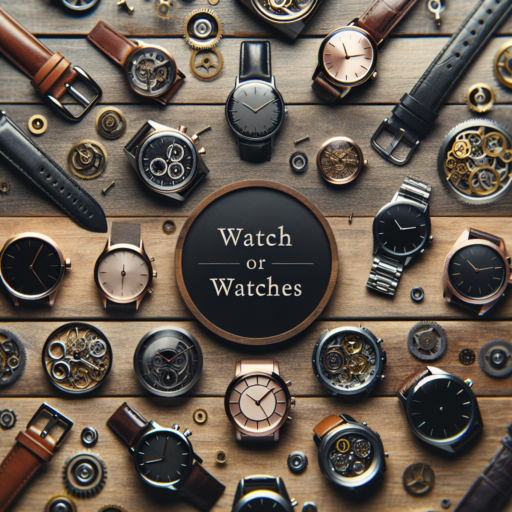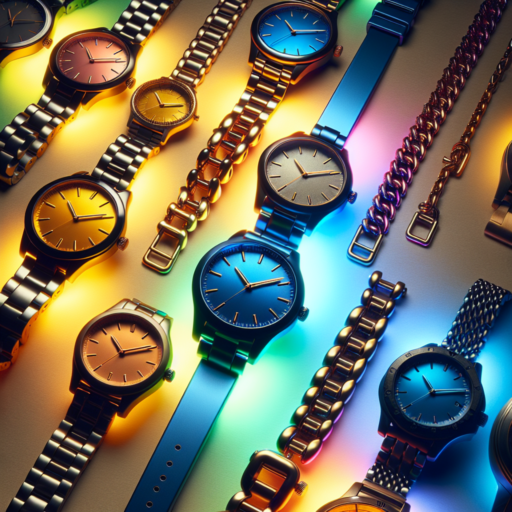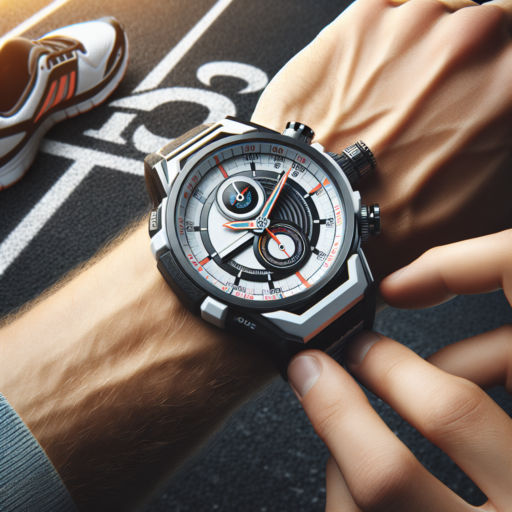Types of Watches: Finding the Perfect Timepiece for You
Selecting the right watch isn’t just about telling the time; it’s also a reflection of your personal style, professional needs, and even your interests. Watches come in endless styles and forms, and understanding the variety can help you choose a timepiece that’s as unique as you are. Below, we explore a few popular types of watches that cater to different preferences and functions.
Analog Watches: The Classic Choice
Analog watches are perhaps the most traditional type of watch, characterized by their hour and minute hands, with numbers, markers, or Roman numerals representing the hours. These watches are versatile and timeless, suitable for both casual and formal occasions. Whether you’re attending a business meeting or going out for a casual dinner, an analog watch can complement your outfit perfectly.
Digital Watches: Functionality Meets Style
Digital watches, displaying the time in numerical form on an LCD or LED screen, combine modern technology with practicality. These watches often come with additional features such as alarms, stopwatches, and backlights, making them a favorite among athletes and individuals with an active lifestyle. If you value functionality and a futuristic look, a digital watch might be the right choice for you.
Smartwatches: The High-Tech Companion
Smartwatches have revolutionized the watch industry by offering an extension of your smartphone right on your wrist. With capabilities such as making calls, sending messages, tracking your fitness, and even paying for your purchases, smartwatches cater to the needs of the tech-savvy individual. If you’re someone who loves staying connected and enjoys the latest technology, a smartwatch could be your perfect match.
The Latest Trends in Watch Design for 2023
As we dive into the year 2023, the watch industry has unveiled some compelling trends that blend both innovation and tradition. These trends not only reflect the current taste and style preferences of consumers but also incorporate advanced technological features that enhance the functionality of timepieces. From minimalist designs to eco-friendly materials, let’s explore what’s currently shaping the world of watch design.
Minimalist Design with Maximum Impact
The minimalist trend continues to dominate the watch industry, with manufacturers stripping back to the essentials. This year, simplicity reigns supreme, with clean dials, uncluttered faces, and slim profiles emerging as key characteristics. The focus is on creating pieces that offer elegance and sophistication, proving that sometimes, less is indeed more. The appeal of minimalist watches lies in their versatility—their understated appearance makes them suitable for both casual and formal occasions.
Eco-friendly Materials Making a Statement
In response to growing environmental concerns, the watch industry has seen a significant shift towards the use of sustainable and eco-friendly materials. Brands are experimenting with recycled metals, plant-based leathers, and other sustainable resources to craft their timepieces. This trend not only highlights the industry’s commitment to reducing its environmental impact but also caters to the increasing number of consumers seeking eco-conscious products. The use of innovative materials is setting a new standard in watch design, offering a unique combination of style and sustainability.
Technology Integration in Traditional Timepieces
Blending traditional craftsmanship with modern technology, the latest watches are becoming more than just time-telling devices. Features such as integrated health monitoring, GPS functionality, and connectivity with smartphones are becoming standard. Traditional watchmakers are adopting these technological advancements to meet the demand for smartwatches, while ensuring they retain the classic aesthetics that appeal to watch enthusiasts. This fusion of technology and traditional design is revolutionizing the way we view and use watches, making them an indispensable lifestyle accessory for the digital age.
How to Choose the Right Watch for Your Wrist Size and Style
Choosing a watch that complements your wrist size and personal style is key to ensuring that it fits comfortably and looks proportional. The first step is to measure your wrist. Typically, wrists smaller than 6 inches are considered small, 6 to 7 inches are medium, and larger than 7 inches are classified as large. A well-suited watch for your wrist doesn’t just enhance your style but also boosts your confidence.
Determining Your Style Preference is as crucial as understanding your wrist size. Your lifestyle plays a significant role in this choice. Are you more inclined towards a formal look, or do you favor a casual style? Maybe you are interested in a versatile watch that fits both scenarios. For formal attire, classic timepieces with minimalist designs often stand out. In contrast, for a more relaxed look, digital or sporty watches with durable bands are favorable.
Consider the Watch Case Diameter. For small to medium wrists, a diameter of 34mm to 40mm is usually ideal, ensuring the watch does not overpower your wrist. On the other hand, larger wrists may require case sizes ranging from 41mm to 46mm for a proportionate fit. This metric is fundamental in achieving the desired aesthetic and, ultimately, your satisfaction with the watch.
Watch Maintenance: Tips and Tricks to Keep Your Watch in Top Condition
Maintaining your watch is crucial to ensure it runs accurately and lasts for years. A well-maintained watch not only tells time with precision but also reflects your attention to detail and care for your possessions. Whether you own a luxury timepiece or a daily wear watch, following these simple maintenance tips can significantly extend its lifespan and keep it looking as good as new.
Regular Cleaning is Key
One of the most important aspects of watch maintenance is regular cleaning. Dust, dirt, and body oils can accumulate over time, affecting its appearance and functionality. Gently wiping your watch with a soft, dry cloth every day can prevent buildup. For more thorough cleaning, use a mixture of warm water and mild soap. However, ensure the water resistance level of your watch before using any liquid for cleaning.
Professional Servicing
Even with diligent care at home, every watch needs professional servicing once in a while. Depending on the type of movement, experts recommend servicing mechanical watches every 3-5 years and quartz watches every 4-6 years. During servicing, a professional will disassemble the watch, clean each component, replace worn parts, and reassemble it, ensuring it operates seamlessly.
Understanding Watch Movements: Quartz vs. Mechanical vs. Automatic
At the core of every watch lies its heart—the movement. This essential component dictates not only the accuracy but also the value and appeal of the timepiece. When delving into the world of watches, distinguishing between Quartz, Mechanical, and Automatic movements becomes crucial. Each type offers a unique combination of precision, maintenance, and craftsmanship, addressing diverse preferences and lifestyles.
Quartz movements are celebrated for their accuracy and reliability. Powered by a battery, their electronic oscillator is regulated by a quartz crystal, ensuring consistent timekeeping with minimal deviation. This type of movement is ideal for individuals seeking practicality and precision, without the necessity for regular winding. Additionally, watches with quartz movements tend to be more affordable, offering an accessible entry point into the world of fine timepieces.
On the other hand, Mechanical movements represent the traditional essence of watchmaking. They require manual winding to operate, harnessing energy from the wearer’s movements to function. This intricate craftsmanship appeals to purists and collectors alike, who value the artistry and historical significance of their timepieces. Despite their susceptibility to slight inaccuracies compared to quartz, mechanical watches are often cherished for their aesthetic and emotional value.
Blending the best of both worlds, Automatic movements, or self-winding mechanical movements, eliminate the need for daily winding. They are powered by the natural motion of the wearer’s wrist, making them convenient for daily wear. Automatic watches often feature a transparent case back, showcasing the complex engineering and beauty of the movement inside. While they share the appeal of mechanical watches in terms of craftsmanship, they offer an added layer of practicality for the modern wearer.
The Best Watch Brands: What Makes Them Stand Out
Exploring the elite in the timekeeping industry reveals a fascinating story of innovation, craftsmanship, and heritage. The best watch brands distinguish themselves through a relentless pursuit of excellence, a dedication to precision, and an unwavering commitment to aesthetic elegance. From the Swiss valleys to the workshops of Japan, these brands have been pioneers in advancing the art and science of watchmaking.
Swiss craftsmanship is often the benchmark for quality in the world of watchmaking. Brands like Rolex, Patek Philippe, and Audemars Piguet stand at the forefront, known for their meticulous attention to detail, durability, and timeless designs. These brands have mastered the art of creating mechanical timepieces that are not just watches, but pieces of wearable art that represent a legacy of over a century of expertise.
On the other side of the globe, Japanese precision is epitomized by brands such as Seiko and Casio. These companies have revolutionized the industry with their pioneering quartz technology, which offers unparalleled accuracy. Their ability to blend functionality with style has made them favorites among those who value reliability and practicality in their timepieces.
Moreover, the rise of smartwatch technology has introduced new players like Apple into the arena, who bring a fresh perspective to watchmaking. This fusion of technology and traditional watch design appeals to a modern audience, who seek more than just timekeeping from their wristwear. These brands challenge the status quo, proving that the best watch brands are not just those with a long history, but also those that adapt and innovate to meet the changing needs and tastes of consumers.
Smart Watches vs. Traditional Watches: Which is Right for You?
In the current era of technology, the debate between Smart Watches and Traditional Watches is more relevant than ever. Both have their unique place in the worlds of functionality and fashion, making the choice between them a matter of personal preference and lifestyle needs. Smartwatches have revolutionized the way we interact with our environment, offering features that go far beyond the basic tracking of time. They function as mini-smartphones on your wrist, providing notifications, fitness tracking, and even mobile payment options.
On the other hand, traditional watches have stood the test of time, offering reliability, simplicity, and an unmatched elegance. For many, a classic watch is not just a timekeeping device but a symbol of style and sophistication. Traditional watches also boast an impressive variety, from luxury brands that offer a statement piece to timeless designs that exude a subtle elegance.
When considering Smart Watches vs. Traditional Watches, it’s essential to assess your lifestyle and what you expect from a watch. Smartwatches are ideal for those who appreciate technology and its conveniences, whereas traditional watches might appeal more to individuals who value craftsmanship and a timeless accessory.
The Evolution of the Watch: From Sundials to Smartwatches
The journey of timekeeping devices spans millennia, illustrating mankind’s perpetual quest to measure and harness time. Watches have evolved significantly over the centuries, from the rudimentary sundials of ancient civilizations to the highly sophisticated smartwatches of the digital age. This evolution not merely reflects technological advancements but also changes in societal needs, fashion, and our interaction with time itself.
From Ancient Sundials to Mechanical Marvels
The earliest timekeeping devices were sundials, relying on the sun’s position to cast a shadow that indicated time. However, the invention of mechanical clocks in the 14th century marked a pivotal point in the evolution of watches. These mechanical marvels were initially large, stationary devices. It wasn’t until the 16th century that watches became wearable, offering a new level of convenience and personal time management. The introduction of the spring-powered clock in the 15th century further revolutionized watchmaking, leading to the development of smaller, portable timepieces.
The Quartz Revolution and the Rise of Digital Watches
The 20th century introduced another significant milestone with the invention of the quartz watch. This technology utilized a quartz crystal to keep time, a method far more accurate than mechanical movements. The quartz revolution in the 1970s led to the mass production of digital watches, showcasing features like LED displays and later, LCD screens that provided users with not just the time but also dates, stopwatch functions, and alarms. This era underscored a shift towards functionality and precision in timekeeping.
Today, the lineage of timekeeping devices continues to evolve with smartwatches, which blend traditional timekeeping with the functionalities of a smartphone. These modern marvels keep users connected, offering notifications, fitness tracking, and even mobile payments, signifying a new chapter in the dynamic narrative of watch evolution.
How to Spot a Genuine Watch: Avoiding Counterfeits in the Market
In today’s market, discerning between a genuine watch and a counterfeit can be a daunting task. However, with the right knowledge and attention to detail, you can protect yourself from falling victim to fake timepieces.
Examine the Craftsmanship
Luxury watches are renowned for their impeccable craftsmanship. When examining a watch, take a closer look at its finish. Authentic watches boast a flawless finish without any signs of poor engraving or printing. The watch should feel solid and heavy in your hands; this is often indicative of the quality materials used in genuine pieces. Counterfeit watches, on the other hand, may feel lighter due to the cheaper materials employed.
Check the Watch Movement
The movement of a watch is its heartbeat. Most luxury watches use a smooth sweeping motion rather than a ticking one. If you can, take a look at the watch’s movement. Authentic luxury watches usually feature highly intricate movement systems, which are difficult for counterfeiters to replicate. If the movement seems overly simplistic or does not match the known mechanisms used by the brand, it’s a strong indication the watch might be a fake.
Verify with Serial Numbers
Serial numbers are a vital aspect of authentic watches. They are unique to each piece and can often be verified with the manufacturer. Check for the serial number on the watch and contact the brand directly to confirm its authenticity. Counterfeit models typically use fake serial numbers that do not match the brand’s records or, in some cases, reuse the same number across multiple watches.
Identifying a genuine watch requires careful attention to detail and a bit of research. By examining the craftsmanship, checking the watch movement, and verifying serial numbers, you can increase your chances of spotting an authentic piece amidst the counterfeits in the market.
Top Watch Accessories Every Collector Should Own
As a watch enthusiast, your collection is more than just time-telling devices; it’s a reflection of your style, passion, and appreciation for craftsmanship. To elevate your collection and ensure its longevity, there are several key accessories that every collector should consider. These not only enhance the functionality and appearance of your watches but also play a crucial role in maintenance and display.
Watch Winders:
For collectors with automatic watches, a watch winder is indispensable. It keeps your watches running accurately when not worn, ensuring that complications like the date and moon phase are set correctly. By mimicking the movement of a wrist, it ensures the longevity of your watches, preventing the oils inside from coagulating, which can affect timekeeping accuracy.
Cleaning Kits:
Maintaining the pristine condition of your watches is crucial, and for that, a cleaning kit specifically designed for watches is a must-have. These kits often include soft cloths for polishing, brushes for detail cleaning, and solutions safe for use on metals and crystals. Regular cleaning not only keeps your watches looking their best but also helps in preventing the build-up of dirt that can wear down the moving parts over time.
Storage Solutions:
Proper storage is essential for any collector. Whether it’s a watch box for your most prized pieces or a safe with humidity and temperature control for vintage or highly valuable watches, protecting your collection from environmental factors is crucial. Adequate storage not only prevents scratches and damage but can also provide an attractive way to display your watches, making them easily accessible while keeping them secure.










